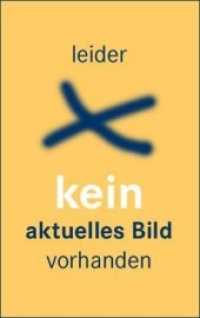Full Description
This volume presents the up-to-date results of investigations into the Asian origins of the only two language families of North America that are widely acknowledged as having likely genetic links in northern Asia. It brings together all that has been proposed to date under the respective rubrics of the Uralo-Siberian (Eskimo-Yukaghir-Uralic) hypothesis and the Dene-Yeniseian hypothesis. The evolution of the two parallel research strategies for fleshing out these linguistic links between North America and Asia are compared and contrasted. Although focusing on stringently controlled linguistic reconstructions, the volume draws upon archaeological and human genetic data where relevant.
Contents
List of Tables and Illustrations
Abbreviations
Introduction
Michael Fortescue and Edward Vajda
Part 1 The Uralo-Siberian Hypothesis
1 Overview
2 The Eskaleut, Uralic and Yukaghir Languages
2.1 Eskaleut
2.2 Uralic
2.3 Yukaghir
3 The History of the Hypothesis
4 Uralo-Siberian Cognates
4.1 The Basis of the Reconstructions: Sound Correspondences
4.2 Proto-Uralo-Siberian Stems
4.3 Proto-Uralo-Siberian Morphology
4.4 Summary
5 The Relationship to Chukotko-Kamchatkan
6 The Emergence of Ergativity in Eskaleut and Siberian Languages
7 Aleut Lexical Items Not Attested in Eskimoan: Evidence of a Substratum?
8 Sirenikski: Remnant Asian Eskimoan
8.1 The Position of Sirenikski within Eskimoan
8.2 Sirenikski Phonology and Lexicon
8.3 Sirenikski Morphology
8.4 The Idiosyncrasy of Sirenikski
9 Support from Archaeology and Population Genetics
9.1 The Dispersal of Uralo-Siberian: A Model
9.2 Archaeological Support for the Model
9.3 Genetic Support for the Model
Part 2 The Dene-Yeniseian Hypothesis
1 Overview
2 Yeniseian Languages
3 Na-Dene: Tlingit, Eyak, and Dene (Athabaskan) Languages
4 Dene-Yeniseian Phonology
5 Dene-Yeniseian Cognates
6 Form Classes and Noun Morphology
7 Possessive Constructions
7.1 Yeniseian Possessive Morphology
7.2 Dene-Eyak Noun Class Markers and Qualifiers
7.3 Postpositional Constructions
7.4 Directionals
7.5 Demonstratives and Interrogatives
7.6 Summary
8 Finite Verb Morphology
8.1 The Origin of Dene-Yeniseian Templatic Polysynthesis
8.2 Na-Dene Classifier Prefixes
8.3 The Proto-Yeniseian Template
8.4 Tense-Aspect-Mood Affixes
8.5 Agreement Morphology
8.6 Contact-Induced Changes in the Yeniseian Daughter Templates
8.7 Areal Influence on Na-Dene Verb Morphology
8.8 Action Nominals
8.9 Concluding Remarks on Dene-Yeniseian Verb Morphology
9 Summary of the Linguistic Evidence for Dene-Yeniseian
10 Perspectives on Dene-Yeniseian from Genetics and Archaeology
11 Summary and Future Perspectives
Concluding Discussion
Michael Fortescue and Edward Vajda
Appendix 1: P-US to English; English to P-US
Appendix 2: P-DY to English; English to P-DY
References
Index






